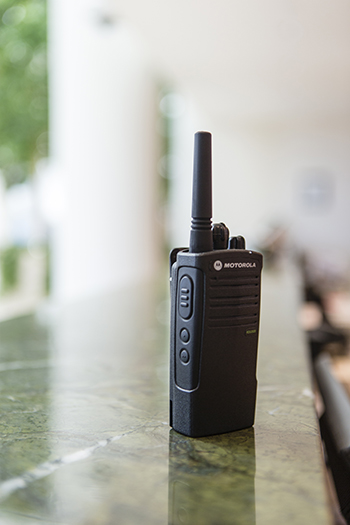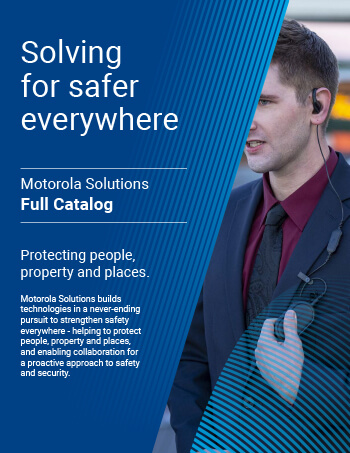Radio Solutions Considerations
RADIO DEPLOYMENT SOLUTION CONSIDERATIONS

Are you planning a two-way radio system?
Here is a list of considerations helpful for us to know when you request a quote or proposal. Preparing this information before
contacting us will be helpful to better define the scope of your project and allow us to provide a more thorough proposal.
In your own words, what are you trying to accomplish?
Instead of listing “radios for my schools” or “radios to talk,” let’s try and identify specifically what you would like these radios to do. Things like reducing response times, fixing coverage gaps, and reducing cellular expenditures are all good examples. The more specific you can be, the better proposal we can make for your underlying needs.
Coverage Requirements
Is this a single building, campus, or do you need a wide area covered?
Number of Locations
- Do you have multiple locations that are geographically separated?
- Do they need to be able to communicate with each other?
- Do you need to be able to communicate to a central point (for example, Corporate Headquarters or Global Security Ops Center?
Environmental Conditions
Will radios be operated indoors, outdoors, or both? Will they experience extremes of cold, heat, damp/rain, dust, etc?
Imagining all potential locations of operation: are they loud, quiet, or both?
Will radio operators be working in a hazardous environment?
Number of Radio Users
How many people will need consistent access to a radio? Remember to include:
- Handhelds
- Vehicles (mobile radios)
- Fixed locations, for example: dispatch, security desk, front desk, etc
Besides determining a radio count for a quote, having a solid idea of these numbers may impact the type of infrastructure needed.
Number of Departments or Talkgroups
Almost more important than the total number of individual users is the understanding of different talkgroups that will be using the radio system.
For instance, a hotel might have security, engineering, front of house, catering/events, housekeeping, and maybe a few others.
Understanding these talkgroup dynamics of where they’ll need coverage and how much voice traffic to expect could impact your radio model selection as well as your infrastructure needs.
Accessory Considerations
Don’t underestimate the importance of accessories! Accessories have a very high correlation to the satisfaction of your end users. Here are some widely-implemented considerations:
- Speaker Mics?Also known as lapel mics, they are often clipped to your shirt or lapel and allow the user to listen and respond to radio calls without removing their radio from their belt clip.
Benefits include:
- Easier to hear incoming transmissions, since the radio speaker is much closer to the ears
- Less frequent equipment drops, since it is secured during use (extends life of equipment)
- Keep equipment away from elements (under clothing or in a carrying case), further protecting radio from wear and tear
- Some speaker mics have noise cancelling or other audio improving properties
- Surveillance Kits?Sometimes referred to as earpieces, there are many options to choose from, including:
- 1 Wire: very common, includes Push To Talk (PTT) all on one wire and is the most simple solution
- 2 Wire: common in security, the wire has a ‘Y’ shape with one wire leading to the earpiece and one leading to PTT+Mic
- 3 Wire: less common solution for advanced discrete communication, the Mic, PTT, and Earpiece all have separate wires, like a ‘W’ shape
- Listen Only: can be plugged directly into a radio or the 3.5 mm jack on a speaker microphone
- Heavy Duty Headsets? For users who require noise attenuation, heavy duty headsets (sometimes called single muff or dual muff headsets) are required to hear and transmit in ultra-loud environments.
- Bluetooth Devices? This portfolio is a game changer, giving you the flexibility to remove the radio from your belt and stay connected within 30 feet. However, though wire-free bluetooth is a popular technology, keep in mind it can be another point of frustration for your users regarding pairing, usage, and charging. It’s best to test a specific Bluetooth device and deploy it organization-wide rather than relying on a BYOD (bring your own device) Bluetooth policy. There can be compatibility issues with connecting to Bluetooth, so make this a point of discussion while designing your solution. More About Bluetooth Accessories
- Carrying Accessories? Radio carrying cases, especially when used with an audio accessory, can extend the life of your radios due to reducing wear and tear from drops, knocks, and weather.
- Multi-Unit Chargers? For users or departments that pick up their radios at the start of a shift, multi-unit chargers take the clutter out of having dozens of individual wall outlets being used by single chargers. Smart chargers will be able to display the charge level of the batteries along with the lifespan left on the battery.
- UL/Intrinsically Safe Batteries? Do you work in a hazardous environment? UL/Intrinsically Safe batteries have been lab tested and approved to not cause a spark for use in hazardous locations. If you do not know if intrinsically safe equipment is a requirement for your business, contact your safety manager.
- Antennas - the come with two lengths, usually: a whip and a stubby (~3”). Standard radios come with a whip-length. There is no extra cost to switch to a stubby antenna at deployment, which can be easier to handle, but will have less range.
Software Applications
Does your organization use any applications that might extend to radio users? Today, some radios have light data capability and some are full blown smart devices. By extending your work applications to radio users, you are able to leverage your existing software investment while needing to carry less devices. Some common applications include:
- Work order tickets
- Dispatch
- Indoor/outdoor GPS
- Email or Text
- Telephone interconnect
- Need to extend radio to Broadband (non-radio) users
Once you’ve identified these considerations, you may then want to review and begin addressing our Pre-deployment Checklist, which are the next steps in the Two-Way Radio deployment process. As always, Contact Us with questions or to get the conversation started!
Ready to get started? Visit our Radio Solutions Builder
OTHER HELPFUL LINKS:
Two-way Radio Pre-Deployment Best Practices
Two-way Radio Deployment: Training and Protocols
Two-way Radio Post-Deployment: Key Takeaways
Two-way Radio Devices and Applications
Motorola Accessories by Device Type



